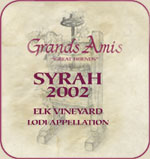 |
|
Wine Details
Price:
$17.99 per bottle
Description:
It has a good color concentration with a bouquet that focuses on lush red fruit: strawberries, intensely ripe raspberries, and candied cherries. The French oak imparts a sweet vanilla oak character with notes of cinnamon and cloves, along with campfire smokiness and hints of lavender tea. The finish is lingering and textured. Alcohol 14,2%.
This wine was awarded Best of Class of Region Lodi Appellation at the 2004 California State Fair. This Syrah is also a favorite among the non-Syrah drinkers.
|
|
|